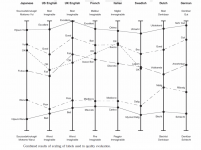You know guys I like the recommendations. But I do not like unsupported claims and pseudo-theories that are often offered by 'gurus' that in fact try to support their design philosophy and commercial success at first place.
There's a good reference to the need for a multitone stimulus in R.A.Belcher's 1978 WW paper 'A new amplifier distortion measurement'.
If you read in other threads, you will see that my key target is the fight with EMI interference and its influence to audio signal.
+1 - stuff by Bill Whitlock (and before him, Jensen) I hope you've digested already then
Yes, nothing significant measured.
But it doesn't prove that it applies to multitone aperiodic signals like music which atr much more complex.
I am all for good measurement tools, but extending what they say beyond their reach i am not.
The test you have shown, shows only that the DUT is good at doing the test you have subjected it to. A useful design tool, but more?
dave
Dave, good measurements are a necessary condition for transparent sound. Measurements are the only way how to present properties of a DUT in a web discussion. 'Good sound' cannot be evaluated by discussion, you need to be there and listen.
In case you are concerned about behavior of the well designed circuits when transferring asymmetric signals with zero DC, would you kindly provide me with a link to a measurement of any problems of this kind? Please get rid of 40 years old experiments with uA741, 4558, TIM with those devices and other similar 'proofs' often used in the BT thread. I would like to see a measurement on something like OPA 627 that would show problems with asymmetric signals or multitones.
In case you are concerned about behavior of the well designed circuits when transferring asymmetric signals with zero DC, would you kindly provide me with a link to a measurement of any problems of this kind? Please get rid of 40 years old experiments with uA741, 4558, TIM with those devices and other similar 'proofs' often used in the BT thread. I would like to see a measurement on something like OPA 627 that would show problems with asymmetric signals or multitones.
good measurements are a necessary condition for transparent sound.
But good measurements do not guarantee transparent sound.
dave
But good measurements do not guarantee transparent sound.
dave
It is a necessary condition. We have necessary and satisfactory conditions. Poorly measuring circuit is unable to provide transparent sound. Some may like it of course. Please do not push me to point at design schools that can never be transparent, though they have crowds of supporters and admirers. Transparency does not necessarily mean attractiveness.
Any support for your claims? Is transparency a subjective measure? Are SE triode amps with high distortion transparent? In case you say yes, then meaning of the word 'transparent' is totally different for us. Can the circuit with high noise and high distortion be transparent?
Any support for your claims?
Only anecdotal.
Any support for your? Replicated scientific studies that correlate the measures to what the ear/brain perceives.
Logically it may seem to make sense, but that proves nothing.
Transparency on sine waves does not mean transparency with music.
dave
I think 'transparency' is usually used in the sense that it is "easier" to hear into the sound, and note subtle aspects of what's going on in the performance. But this can be because of 2 reasons: first is that a degree of low level detail is effectively masked because of the behaviour of the amplifying device, meaning that one's hearing system has less "noise" to contend with, and this makes it easier to perceive the primary musical content, the direct sound of the instruments; the second is that all of the low level detail, the ambience clues are also all conveyed clearly, and they make sense to the listener in the same way as live sound is heard. Trouble is, there's a middle ground where most of the low level detail is reproduced, but this is done badly, it's distorted - and the judgement is, 'poor sound'.
Classic tube systems do a lot of the first type of transparency, but the second is the better goal, IMO, unfortunately is harder to achieve, because it requires very high levels of technical performance ...
Classic tube systems do a lot of the first type of transparency, but the second is the better goal, IMO, unfortunately is harder to achieve, because it requires very high levels of technical performance ...
- Status
- This old topic is closed. If you want to reopen this topic, contact a moderator using the "Report Post" button.
- Home
- General Interest
- Everything Else
- Small signal myths and real measurements
